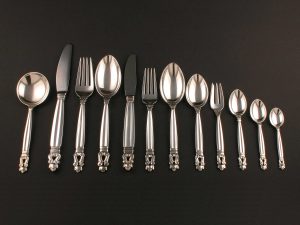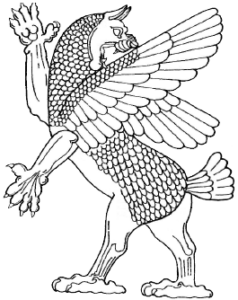Item number: 49130
A sterling silver cutlery for six persons in „Acorn“ pattern,
Copenhagen post 1945 by Georg Jensen
This Acorn flatware service consists of (please refer to the first image, from left to right):
6 large Soup spoons (length 16.1 cm / 6.33″)
6 Dinner knives (length 22.9 cm / 9.01″)
6 Dinner forks (length 18.9 cm / 7.44″)
6 Dinner spoons (length 19.1 cm / 7.51″)
6 Luncheon knives (length 20.4 cm / 8.03″)
6 Luncheon forks (length 16.6 cm / 653″)
6 Dessert spoons (17.2 cm / 6.77″)
6 Sorbet spoons or large Tea spoons (15.6 cm / 6.14)
6 Cake forks (14.1 cm / 5.55″)
6 Tea spoons (12.8 cm / 5.03″)
6 Coffee spoons (11.1 cm / 4.37″)
6 Mocha spoons (9.6 cm / 3.77″)
Weight:
65.16 oz / 2026.9 g (excluding the knives)
This vintage Danish Jensen flatware service is an exceptional gauge of silver, exceptional quality and condition. The Acorn pattern ornamentation is very sharp. Full hallmarks struck to the reverse of each piece are all very clear.
The whole set has been professionally polished and is in exceptional condition. The blades of the knives were professionally replaced, all knives are dishwasher-safe. There are no monograms or inscriptions.
Acorn Pattern is without a doubt Georg Jensen’s most successful silver design and is still in regular production. The actual price at George Jensen would be 14.700,- EUR. The whole set bears post-war Georg Jensen marks apart from the soup spoons which bear the Georg Jensen marks of 1933 – 44.
The set can be extended with butter knives as well as relating the number of people and with serving pieces on demand.
Johan Rohde and Georg Jensen
The Danish painter, graphic artist, architect and interior designer Johan Rohde [1856 – 1935] was a co-founder of the secessionist group “Den Frie Udstilling” (“The Free Exhibition”) in 1891. Through this group he met Georg Jensen, who exhibited a sculpture rejected by the Danish Academy at “Den Frie Udstilling” in 1897. Georg Jensen intended to pursue a career as a sculptor at a young age before he had unexpected success with his silverware. Born in 1866 as the son of a knife grinder in Raadvad, north of Copenhagen, Georg Jensen began training as a silversmith at the age of 14 and became a journeyman in 1884. From 1887 to 1892 he studied sculpture at the “Kongelige Danske Kunstakademi” (“Royal Danish Academy of Art”), followed by studies in pottery. However, economic difficulties forced Georg Jensen to abandon his artistic ambitions in sculpture and pottery and to rededicate himself to silver. Therefore, he worked in Mogens Ballin’s silversmithy from 1901. Nevertheless, the knowledge he acquired at the academy was later of great benefit when he combined it with his specialist knowledge of silversmithing and thus revived the lost tradition of the classical craftsman. His designs for jewellery and silverware, strongly influenced by Scandinavian Art Nouveau, soon found public favour, encouraging Georg Jensen to leave his position with Mogens Ballin and establish his own workshop in Copenhagen in 1906. Georg Jensen and Johan Rohde became friends during their time at Mogens Ballin’s silversmithy, for which Johan Rohde provided designs. Rohde’s first designs for silverware, which he created for his own house in 1905, were executed by Georg Jensen. From 1908, Johan Rohde began a casual collaboration with Georg Jensen. It was not until 1917 that Rohde became a permanent designer of silverware for Georg Jensen, where he remained until his decease.
Among Johan Rohde’s most successful designs for Georg Jensen are the silver cutlery “Acorn” (also known as “Konge”), as well as the cutlery “Scroll” or “Saga” and “Acanthus” (or “Dronning”). Among the larger silverware, the silver carafe #432, which has become a design icon, and the silver services of the “Cosmos” pattern have become particularly famous.





